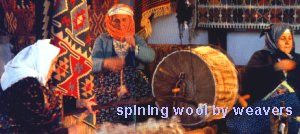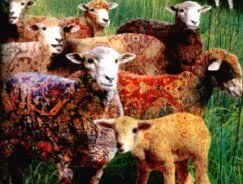
|
Materials
Rugs and the various flatwaves are made from five basic materials;
heep wool, goat hair, cotton, floss silk, and silk.
 Pure
Silk: The silk used in Turkish carpet comes from silk cocoons in Bursa.
It has a very high tensile strenght and can be twisted very finely, plus it
is guite resistant. The finest silk comes from the first part of the amazingly
long single thread with witch silk warm spins its cocoons. When unrolled, the
thread from one silk cocoon can stretch up to 25,000 meters. The best and the
finest hand-woven rugs in the wold are Hereke silk rugs. A normal quality silk
Hereke should have 1,000,000 knots per square meter. To day with tremendous
care, attention and density, some exceptional Hereke silk rugs are woven with
3,240,000 knots per square meter; that is 18 knots vertically on 1 cm. And 18
knots horizontally on 1 cm. This indicates how finely the silk can be twisted
and woven, as well as how strong and resisdent this piles can be. Pure
Silk: The silk used in Turkish carpet comes from silk cocoons in Bursa.
It has a very high tensile strenght and can be twisted very finely, plus it
is guite resistant. The finest silk comes from the first part of the amazingly
long single thread with witch silk warm spins its cocoons. When unrolled, the
thread from one silk cocoon can stretch up to 25,000 meters. The best and the
finest hand-woven rugs in the wold are Hereke silk rugs. A normal quality silk
Hereke should have 1,000,000 knots per square meter. To day with tremendous
care, attention and density, some exceptional Hereke silk rugs are woven with
3,240,000 knots per square meter; that is 18 knots vertically on 1 cm. And 18
knots horizontally on 1 cm. This indicates how finely the silk can be twisted
and woven, as well as how strong and resisdent this piles can be.
 Sheep
Wool: The quality of wool varies according to the climate, the breed of
sheep, and the time of year of the shearing. Wool from sheep that live in warm
and arid regions is normally dry and brittle, and since it breaks so easly,
it ends up being short and feels lifeless. Good quality wool comes from helthy
and well fed sheep found in cold regions or at high elevations with good grazing
lands and lots of water. In the colder regions, sheep grow a full fleece to
keep warm and their bodies store fat which then translates to a high lanolin
content within the fiber which reaches lengths of 10 cm. and more. The wool
so obtained feels silky smooth and yet springy. Wool from the higher elevations
(cooler also) and from the spring shearing is considered to be the highest quality.
Wool is hand-spun by using primative utensils called kirmen (drop Sheep
Wool: The quality of wool varies according to the climate, the breed of
sheep, and the time of year of the shearing. Wool from sheep that live in warm
and arid regions is normally dry and brittle, and since it breaks so easly,
it ends up being short and feels lifeless. Good quality wool comes from helthy
and well fed sheep found in cold regions or at high elevations with good grazing
lands and lots of water. In the colder regions, sheep grow a full fleece to
keep warm and their bodies store fat which then translates to a high lanolin
content within the fiber which reaches lengths of 10 cm. and more. The wool
so obtained feels silky smooth and yet springy. Wool from the higher elevations
(cooler also) and from the spring shearing is considered to be the highest quality.
Wool is hand-spun by using primative utensils called kirmen (drop  spindle)
and by spinning wheels. Women usually spin the wool during idle moments and
the street while spinning. In hand-spun wool,the original length of the fiber
stays the same through the spinning process - a fiber tahat measured 7 cm. before
spinning will still measure the same after spinning. Wool can also industrially
spun, but the hard twisting of the fibers by the spinning machines tends to
berak some of the fibers. Although the broken bits and shorter fibers can be
made to adhere together through the use of oils during the spinning process,
the fiber will have lost some of its strength, which, in turn, will shorten
the life spun of the rugs to be woven. spindle)
and by spinning wheels. Women usually spin the wool during idle moments and
the street while spinning. In hand-spun wool,the original length of the fiber
stays the same through the spinning process - a fiber tahat measured 7 cm. before
spinning will still measure the same after spinning. Wool can also industrially
spun, but the hard twisting of the fibers by the spinning machines tends to
berak some of the fibers. Although the broken bits and shorter fibers can be
made to adhere together through the use of oils during the spinning process,
the fiber will have lost some of its strength, which, in turn, will shorten
the life spun of the rugs to be woven.
Cotton: In rug and kilim weaving, cotton is used mostly for the warp
threads, as well as for the wefts. Compaired to wool, cotton is generally considered
to be a more residant fiber and it is less elastic. So, tighter knots can be
tied on cotton warps as opposed to wool. If very tight knot are tied to a wool
warp, the fiber will break much more frequantly than if the warps w ere of cotton. Consequentl, woolen
pile rugs with high knoting density counts will normally have cotton warps,
for example, in Hereke, Ladik, and Kayseri Bunyan carpets. ere of cotton. Consequentl, woolen
pile rugs with high knoting density counts will normally have cotton warps,
for example, in Hereke, Ladik, and Kayseri Bunyan carpets.
Goat Hair: Goat hair occosionally found in Oriental rugs in the side
bindings (selvedge), but is more frequently found in saddle bags, cushions,
various types of stacks, etc.
Floss Silk: Floss silk, or art silk as it is some times called, is actually
mercerised cotton and is used in certain rugs that are woven in Kayseri. Although
not identical to silk, a somewhat similar look is obtained by mixing cypress
tree fibers with cotton that has been washed in citric acid. Floss silk rugs
are woven with natural cotton warp and weft threads.
|
 |